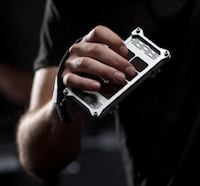aNewDomain.net — Music is truly about motion. Musicians need to move in order to create music. Even singers or seated musicians aren’t standing or sitting rigidly as they perform. Not only is music created from vibration, it requires a human sense of rhythm and motion in order to exist. Musicians often make head gestures or other non-essential bodily motions in order to let their bodies maintain the sense of rhythm.
While music is about motion, there are times when musicians can feel their movements constrained by their very instruments. The pianist cannot dance across the stage while still playing. The drummer must remain behind his kit. Often this constraint is perfectly fine, but then there are other times when it feels like a burden.
So we come to the invention of the AUUG Motion Synthesizer. Designed by Australia’s Joshua Young, who is himself a musician as well as an inventor, the AUUG Motion Synthesizer lets the performer create music at any level of sophistication purely through physical motion. This is wild to observe:
Video courtesy of AUUG
Working through an iPod Touch (generation 5 and up) or iPhone (4S and up), the AUUG Motion Synth gives musicians access to a vast array of sounds to use in expressive ways. Singers can use the AUUG to gain much greater note-shaping range and control — without needing to stick a straw in their mouth or having to know how to play the guitar. AUUG is compatible with MIDI and with music software on computers.
Musicians can even create unique forms of motion-oriented sound control and then share those originals with other musicians. The AUUG cloud-based website has a user-only service and a forum to facilitate this sharing. Tech support and instructional videos will also be found there.
Keys, scales, and octaves are fully programmable. To this writer and musician, one of the most-incredible aspects of the AUUG Motion Synth is how it facilitates the changing of octaves simply by the wearer moving her hand higher or lower. Intuitively, raising the hand upward raises the octave, while moving it downward has an opposite effect. Observe the woman here playing the “violin”:
Video courtesy of AUUG
It’s important to realize that the AUUG app allows for the control of other iOS music apps, and in and of itself is not a music app. One music app wouldn’t be able to give musicians the full palette of expressive ability that they need and desire.
For the beginning student, the AUUG enables the musician to have full engagement with music-making on the very first day. No longer must a novice slog through endless months of daily misery, frustration, and physical discomfort while practicing. Nonetheless, a student will still need to bring talent and discipline to the table. There’s no empty shortcut here — only technology that can sustain many more people’s interest in progressing through the necessary stages of musical development.
Made for Musicians by a Musician
Since Young is a musician himself, he and his engineering team were able to come up with design specs for the AUUG that match up with live performance and intuitive usage demands of musicians.
For one thing, while using the AUUG there is no need for you to grip its casing. It is astoundingly lightweight (just 28 grams) and fits snugly but unobtrusively onto your wrist. All of the energy of your fingers and wrist goes into controlling your app. Ergonomic comfort and skin-breathability were of paramount importance to the designers.
Another important aspect of AUUG is its touchscreen overlay. This is just what music students or musicians who are learning how to use AUUG need in order to learn as quickly and seamlessly as possible. The feedback is both visual and tactile.
Despite its lightweight quality, the AUUG casing is highly durable — a quality that touring musicians certainly value in their instruments. It’s made from aircraft-grade aluminum.
Oh, and if you’ve got a need to change which iOS device you’re using, the AUUG has been carefully designed to make this as simple as switching guitars. Multiple front sections are available so that any iOS device can be fitted into the case and used with the app.
You can see the AUUG’s functional adaptability here:
Video courtesy of AUUG
Windows to the World of Music
AUUG gives users various choices of intuitive windows to use for programming or playing. This fact readily opens up the various worlds of sound and creativity available.
The Performance window gives you eight button zones, each one precisely aligned with the AUUG grip overlay. These are for playing diatonic scales.
The Notes Menu window lets you select, among other options, the scale you desire to play, the scale’s octave, and the activation of orientation-based octave control.
The Motion Menu window gives you a simple menu system for selecting and mixing together the unique motion-to-sound translation algorithms that the company designs. Here you can also configure the way that these translations are outputted via MIDI.
The Presets Menu window lets you load or save presets, including all app settings and your own motion-to-sound translation configuration changes. Here you can also import or export these presets in order to share them with other users on the AUUG cloud.
In Conclusion
I believe that with the AUUG we may hold in our hands a true music revolution. As a musician who loves more-complex music made with real instruments (acoustic or technological) and despises it when machinery gets dressed in the guise of creativity, I see this app as a tech miracle for musicians and music students everywhere. The AUUG can be an authentic instrument or even an advanced mixing board:
Video courtesy of AUUG
We wants it, Precious!
For aNewDomain.net, this is Brant David.
Based in New Jersey, Brant David is a senior writer for aNewDomain.net. Follow him at +Brant David on Google+ and Brant@aNewDomain.net.













